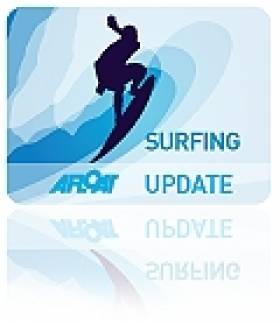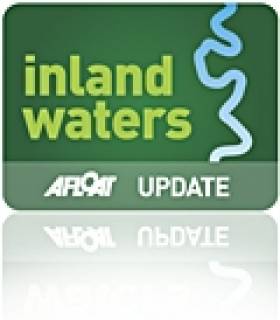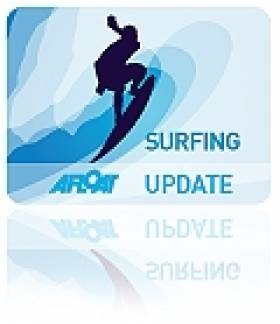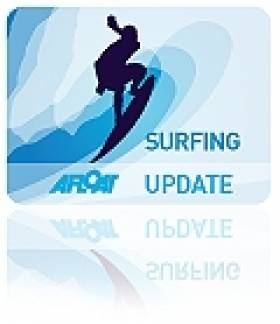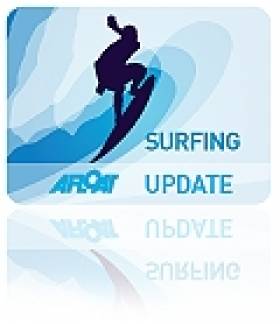Displaying items by tag: west of Ireland
Pre-Christmas Present For Surfers On Ireland's West Coast
#Surfing - Surfers in the West of Ireland will be on standby this week as the latest weather forecasts show a significant swell heading our way across the Atlantic.
According to Surf-Forecast.com, the coastline is already set to experience wave heights of 5 metres or more this afternoon (Sunday 15 December).
But the best may be yet to come, with swells expected to nearly double that height by Thursday (19 December).
And the big wave bounty looks to continue into the following week, providing plenty of opportunity for Ireland's swellseekers to catch a monster before Christmas!
Galway Seminar Discusses Restoration of Western Waterways
#InlandWaterways - International speakers and policy experts are among the delegates in Galway today (23 October) for a seminar to discuss the restoration of inland waterways in Ireland's west region.
Galway Bay FM reports that the seminar is being hosted by the West Regional Authority under the LakeAdmin EU Project, which runs till December 2014 and aims to assess best practice in water management across 10 EU member states.
New Angling Guides and Salmon Bait Restrictions
#Angling - Inland Fisheries Ireland has recently added two new guides to its list of resources for anglers fishing in Ireland.
The West of Ireland Sea Angling Guide covers the region from Westport, in Clew Bay, south to the rocky headlands of North Clare, including Galway Bay, Connemara, Killary, Louisburgh, Clew Bay, and the offshore islands of Inisbofin, Inisturk and the Aran Islands.
The guide is in no way comprehensive, and the list of marks and venues is just a sample of what is available across the region's waterways. There are literally hundreds of shore marks in the region that have rarely, if ever, been fished, but the potential waiting to be explored is immense. Getting off the beaten path and trying a new mark may produce the fish of a lifetime.
In addition, the County Sligo Game Angling Guide covers the main game angling waters in the district. It contains information on the location of each fishery as well as details in relation to contacts, permitted angling methods, angling seasons, etc.
Meanwhile, IFI has received numerous submissions from individual anglers, angling organisations and angling tourist providers regarding restrictions on the use of prawn/shrimp as a salmon angling bait on the River Suir for the 2013 season.
IFI is interested to hear the views of other angling stakeholders or from those who wish to make further submissions.
Submissions can be made to IFI Clonmel by email at [email protected] or by post to Inland Fisheries Ireland, Anglesea Street, Clonmel, Co Tipperary.
The closing date for receipt of submissions is 28 February 2013.
Video Shows Surfers Taking On West Coast Waves
#SURFING - WorldIrish brings us another gem of a video as surf pros take on the challenging waves off the west coast of Ireland.
It's just the latest praise for the Emerald Isle as a world-class surfing destination.
Surfing Is Ireland's 'New National Pastime'
#SURFING - Surfing is Ireland's new national pastime, if the Irish Independent is anything to go by.
The paper's Amanda Phelan travelled to Lahinch - home of 'biggest wave' award hopeful Ollie O'Flaherty - to investigate the boom in surf lessons to young people on the west coast, "one of the new growing business in this region", and meet some of those involved in helping newbies get their feet wet.
"Hundreds of youngsters, some of them locals and others on holiday, line up in Clare to learn surfing, a sport that requires skill, a calm temperament, good leg strength and a lot of courage," she writes.
And courage is something these kids are definitely not lacking, especially with Ireland's famously freezing waters!
The Irish Independent has much more on the story HERE.
Video Shows Best of West Coast Kitesurfers
#KITESURFING - Irish kitesurfing's Mulranny Crew have had their best clips for 2011 compiled on YouTube.
The freestyle crew, based in the West of Ireland, describe themselves as "group of enthusiastic local riders, who try to push themselves harder every time they hit the water."
The group includes Neil McKenna, Kevin Cowley, Rory Stoney, Padraic Doherty, Nick Isherwood, Gavin Hughes, Fionn Wandel Brannigan and Barry Grogan.
See the Mulranny Crew in action on YouTube below:
Galway Students Win Big for Surfing Website
Two students at NUI Galway have won a €15,000 investment in an enterprise competition for their website promoting surfing in Ireland.
Oisin Halpin and Cian Brassil of WestCoastSurfer.com took the top prize at the NUI Galway Student Enterprise Awards earlier this month, with judges convinced by their brand and ability to attract investment to the region, according to Silicon Republic.
“WestCoastSurfer.com has huge growth potential and is well grounded in commercial reality with great opportunities for the West of Ireland,” said chairperson of the judging panel Helen Ryan.


























